Sanford - 2011
'09 maps for:
Bea
--
Buck -- Caley --
Claws --
Conomo --
Hix --
Hudson 09 -- Isabel --
Katy -- L.R. --
Moffet --
Mr. Hannah --
Ozzie --
Penelope
--
Rafael
2010 maps for: Belle
-- Buck --
Gunny --
Hudson --
Mr. Hannah --
Neale --
North Fork Bob
--
Penelope --
Sanford
-- Sr. Bones --
Thatch
2011 maps:
Belle --
Buck --
Henrietta --
Katbird
-- North Fork Bob --
Pemi --
Saco --
Sanford --
Sr. Bones --
Snowy --
Thatch -- Tucker
2012 maps: Art --
Belle --
Bridger --
Chip --
Cutch --
Jill -- North Fork Bob --
Rammie --
Snowy --
Sr. Bones -- Thatch
2013 maps: Art --
Belle --
Bridger --
North Fork Bob --
Rammie --
Snowy --
Sr. Bones
Osprey
main page --
Migration
page --
Migration09 --
Migration10 --
Migration 11 --
Migration 12 --
Migration 13 -- Home
Page
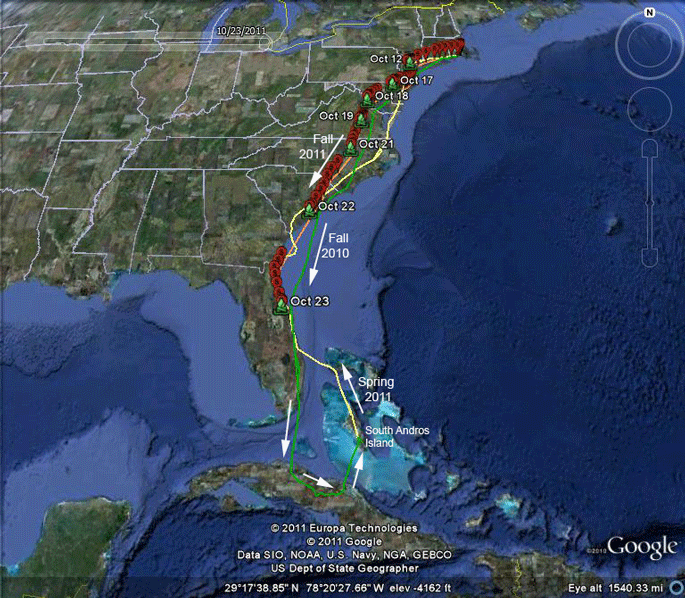 |
12-23 Oct 2011: Sanford was off on the
second migration we've followed for him. This map shows his two trips south and the return this spring. The take-home message here is that Ospreys don't follow landmarks when they're migrating. As birds are migrating, they will take the path of least resistance. Winds from the west when they're heading south will push them to the coast. Winds from the east will shift them inland. Their navigation depends upon some sense of the earth's magnetic fields that we don't yet understand. We were really interested to see how Sanford gets back to South Andros Island, where he spends his winters. Would he take the long route down to Cuba before coming into South Andros through the back door, as he did in 2010, or would he retrace his northbound route and cut over to Andros from the Florida coast? Sadly, we'll never know, because he died crossing Florida near Orlando. He just fell out of the sky, basically. Scroll down for all maps, or... Skip to spring migration, or Skip to fall migration. |
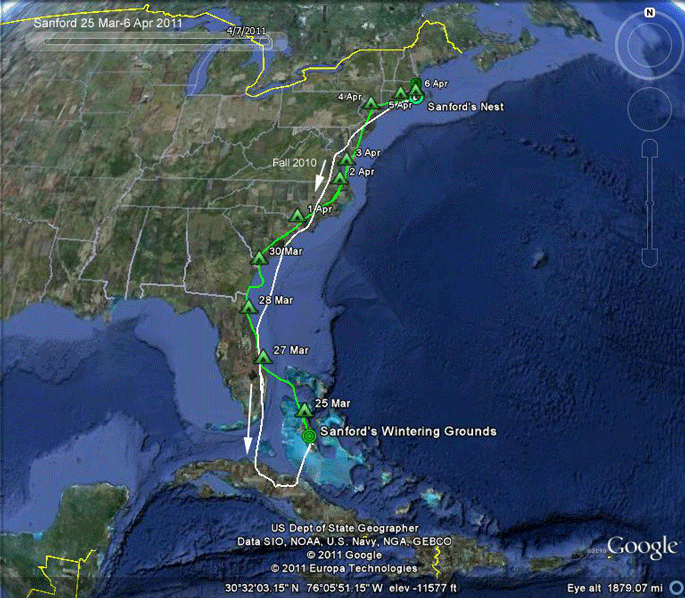 |
Spring Migration: 25 Mar-6 Apr 2011: Sanford got back to his
nesting territory after 18 days of migration. He gave us a bit of a
scare when he was blown out to sea off the coast
of Georgia by a really nasty weather front. His fall track continues to perplex me. Presumably he has done this before, so in the fall why go all the way to Cuba before heading up to the Bahamas? Cuban cigars? Rum? If he has done this before (and all data tells us that adults always go back to the same place each winter), he would know about the shortcut on the way north. Why not use that on the way south? Scroll down for more maps. |
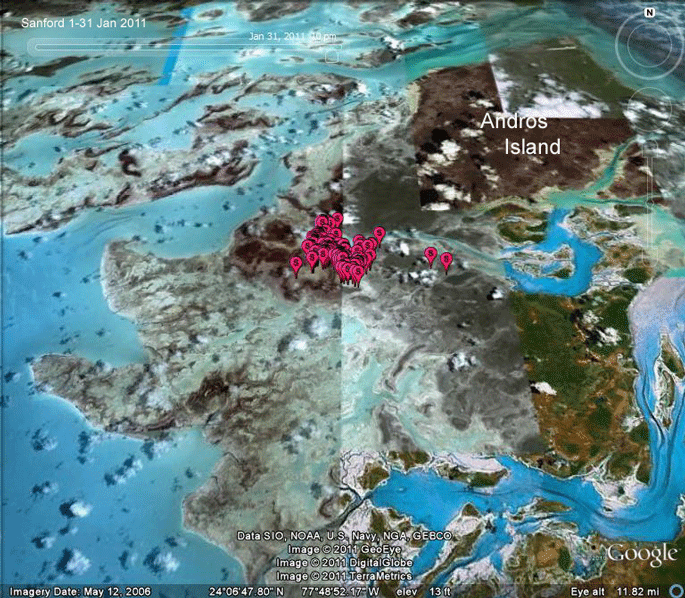 |
1-31 Jan 2011. Sanford is fishing an area about 1.7 miles (2.7 km) across. He should be heading north soon. |
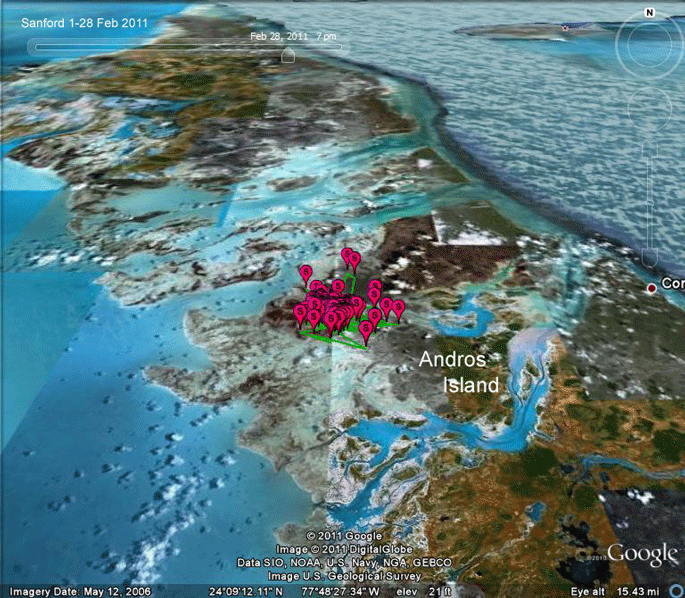 |
1-28 Feb 2011. Sanford is biding time waiting for the day length to get longer, which will trigger hormonal changes, which in turn will get him heading north. |
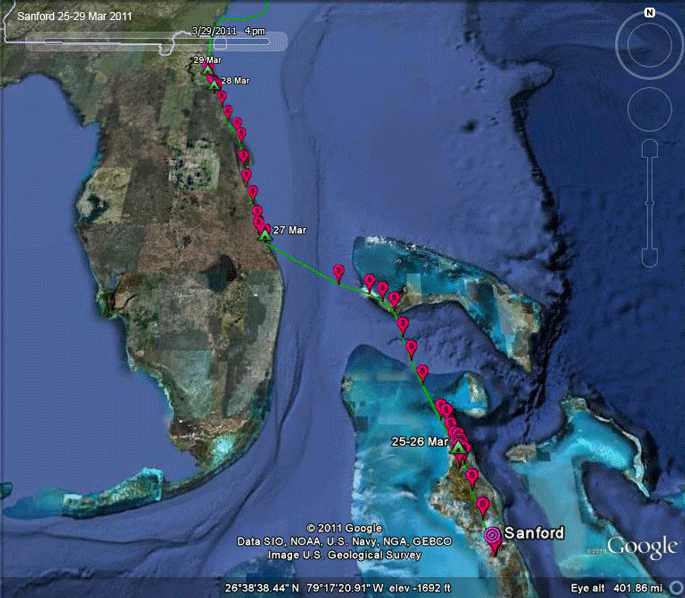 |
1-29 Mar 2011.
Sanford started north on the 25th. He didn't get
very far, stopping for a day on the north end of
Andros Island. There was nothing going on with
weather that day, so who knows why he stopped
for a whole day? He got going again on the 27th and moved up Florida's east coast. Some nasty weather on the 29th slowed him down. |
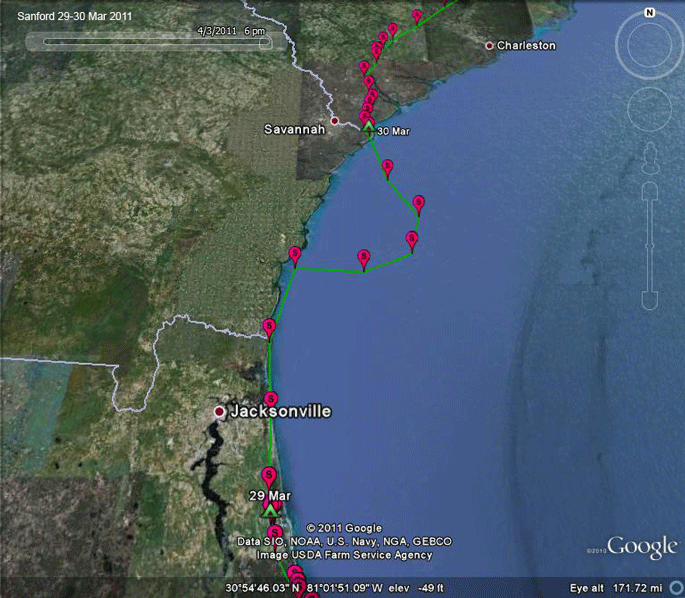 |
29-30 Mar 2011. Sanford got going again on the 30th. He was moving north just off the Georgia coast at 1PM when he was either blown offshore or detoured around a very strong storm front (see below) that was moving through the area. |
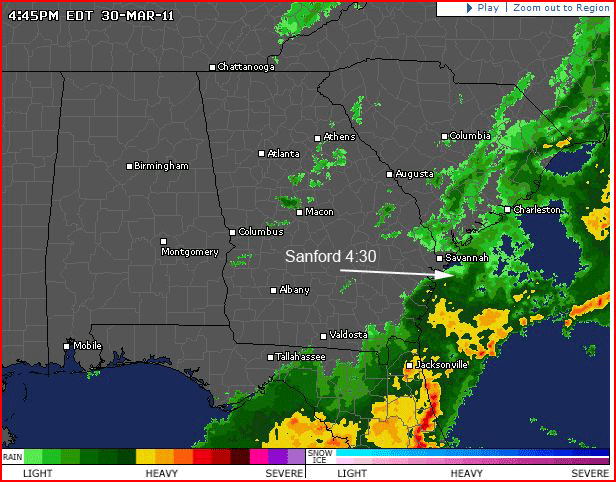 |
30 Mar 2011. Here's the storm that Sanford was dealing with on the afternoon of the 30th. |
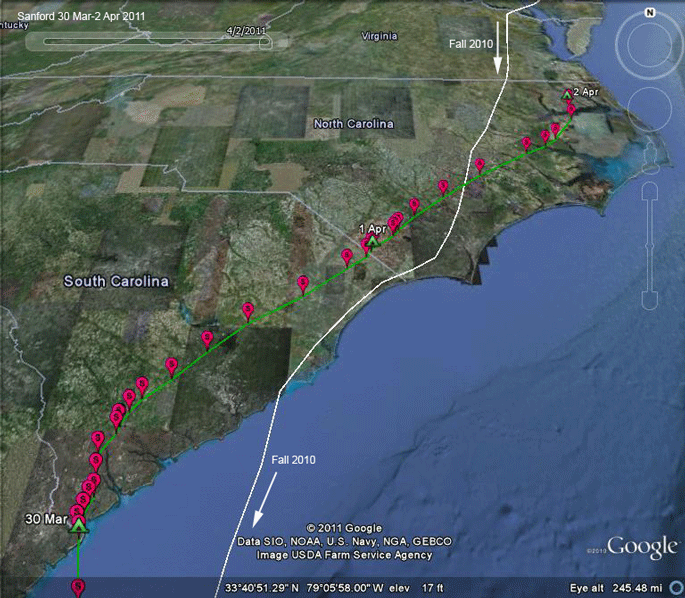 |
30 Mar-2 Apr 2011. After a night near
Savannah, GA, Sanford got down to business,
knocking off South Carolina on the 1st and most
of North Carolina on the 2nd. Once again, we see that Ospreys are not migrating using landmarks, as their fall and spring migrations occasionally cross, but rarely coincide, other than where local geography dictates. |
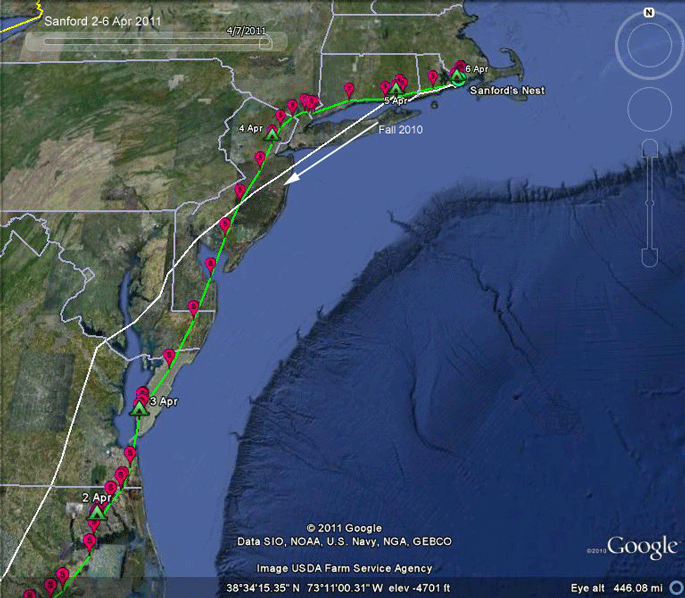 |
3-6 Apr 2011. The last leg of the trip. He ran into some nasty weather, or rather some nasty weather caught up with him on the 5th, which slowed him down a bit in his trip across Connecticut. He could easily have made it from his April 4th roost in northern New Jersey to his nest on the Westport River. |
 |
5 Apr 2011. Sanford spent the afternoon of
the 5th on some rather historical Osprey
territory--in East Lyme between the Connecticut
and Thames Rivers. This was one of the
historical strongholds of the southern New
England Osprey population before the DDT-induced
population crash back in the 50s and 60s. He
arrived at 2 PM and apparently wandered around a
bit before settling down. He left around 8:30 with only about 60 miles to go before dipping his talons in the familiar waters of the Westport River. |
 |
6 Apr 2011. Sanford's back fishing his old favorite places. He does have a bit of drama to deal with because another male, who arrived before Sanford has laid claim to his nest and mate. We don't know if it's the same female, but there were two Ospreys on his nest when he got there. It's probably the same female. Ospreys, like most migratory birds are bonded to a nest location, rather than a particular mate. If both members of a pair return from migration, they will get back to the business of making baby birds. If one dies on migration, it will be replaced. There is no sentimentality in the natural world. Sometimes there are prolonged disputes over which individual will fill a void when a bird doesn't return from migration. These succession struggles can be so prolonged that the birds never get around to mating. |
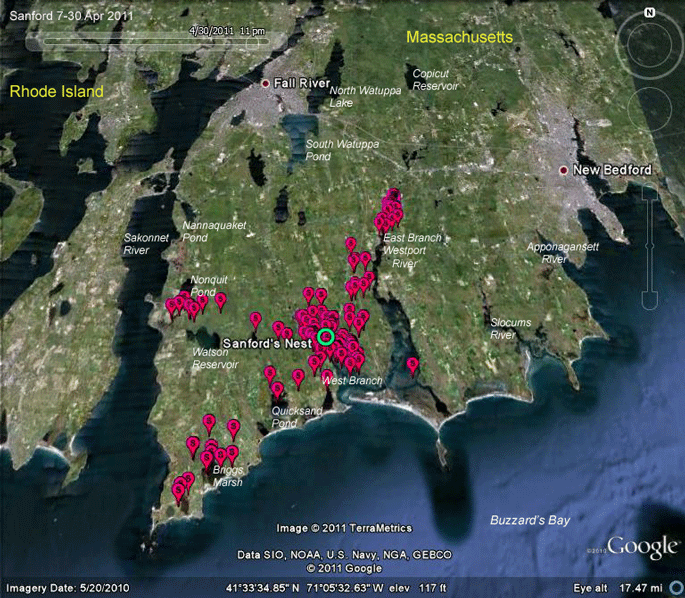 |
7-30 Apr 2011.
Sanford's spent the rest of April around his old
nest area. He did not nest this year. Another
male took over his nest while he was returning
from the Bahamas. When he wasn't around the West Branch, he did a lot of fishing up at the herring run at the headwaters of the East Branch, with an occasional junket over to Nonquit Pond or down to Briggs Marsh. In the maps below, we compare his foraging sites between 2010 and 2011. In both years the herring run ends sometime in May, at which point he shifts his attention to mostly freshwater ponds and reservoirs north and west of his home turf. |
May 2010 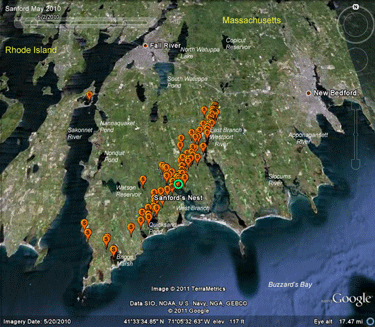 |
May 2011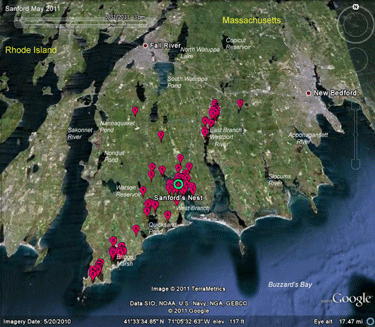 |
June
2010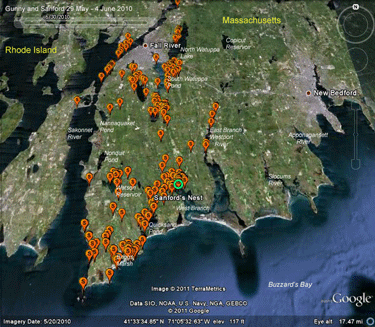 |
June
2011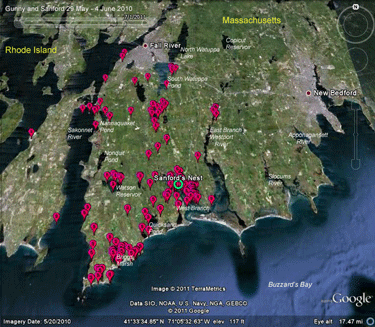 |
| July 2010 | July 2011 |
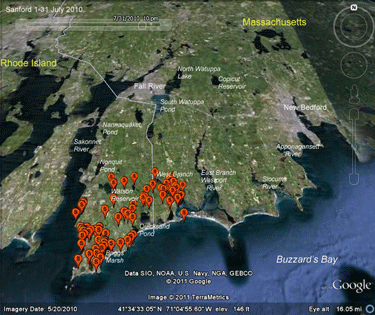 |
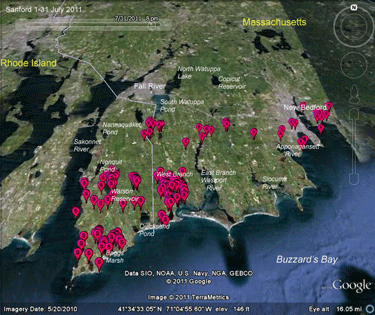 |
| August 2010 | August 2011 |
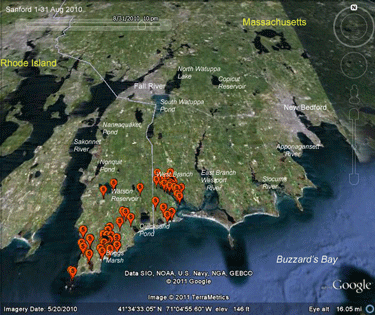 |
 |
| 1 Sept - 2 Oct 2010 | 1 Sept - 12 Oct 2011 |
 |
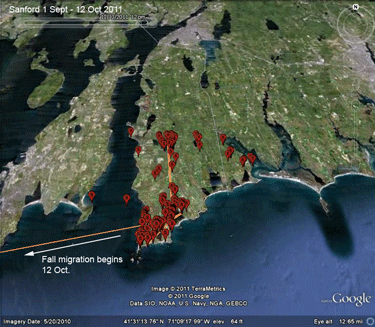 |
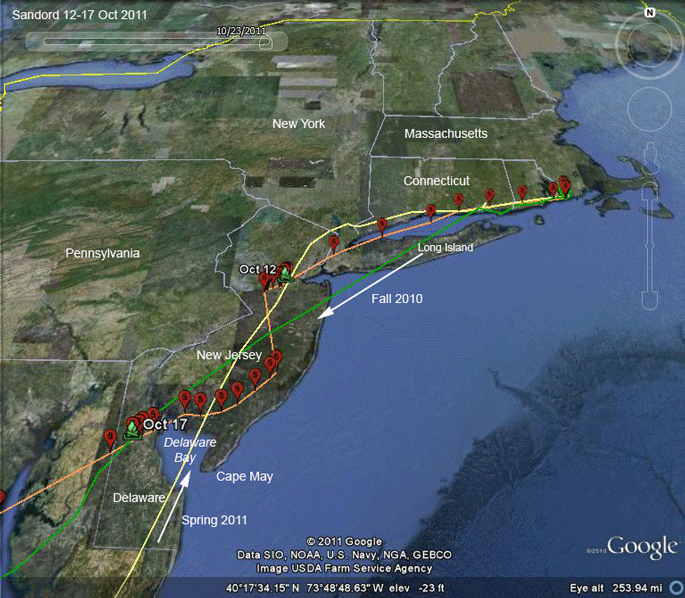 |
Fall Migration 12-17 Oct 2011. Sanford started migration this year 10 days later than in 2010 (green track). After a bit more than 7 hours he settled down for the night near New Brunswick, NJ. The weather turned nasty the next day and Sanford hunkered down to wait it out. On the 17th he got going again, heading south towards New Jersey's Atlantic shore. Before the got there, he turned west and crossed the northern reaches of Delaware Bay and then settlrf down for the night just southwest of Dover, DE. |
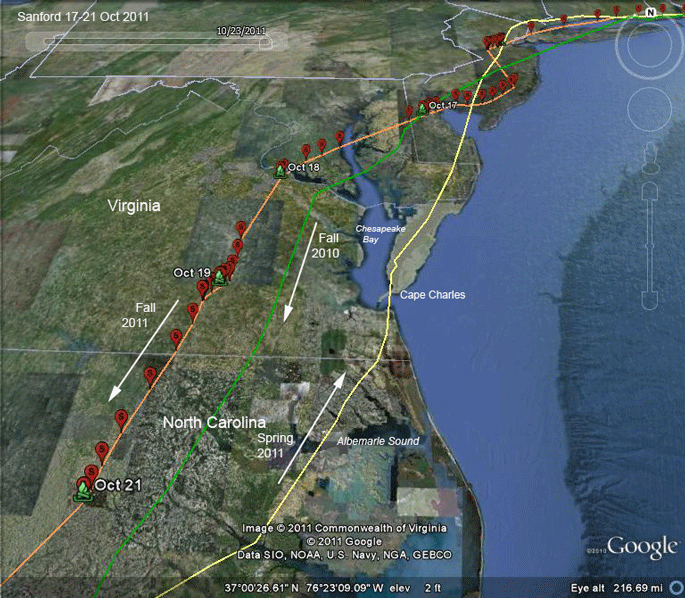 |
17-21 Oct 2011. Sanford pressed on through Virginia and into North Carolina. On the 18th he roosted near the Potomac River about 40 miles south of Washington. On the 19th he stopped east of Dinwiddie, VA, around 3 PM. The next day he only moved 10 miles and spent some of the day fishing some small ponds. On the 21st he crossed into North Carolina and roosted near Goldsboro. |
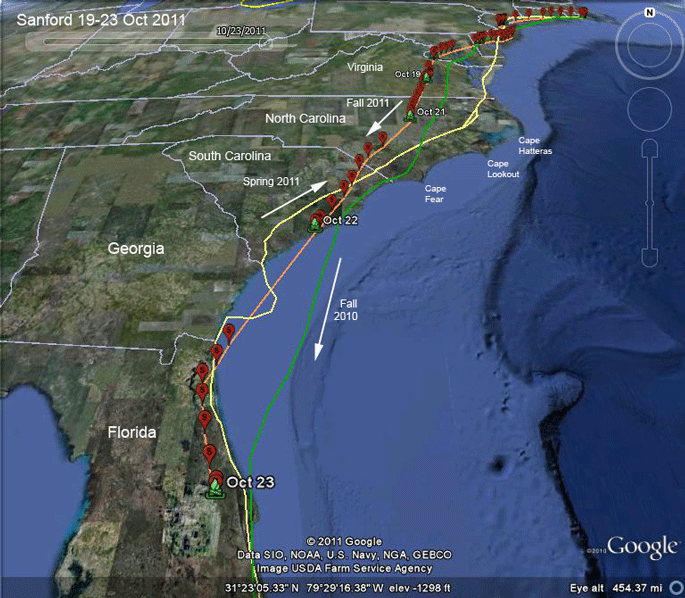 |
22-23 Oct 2011. Last Map. Sanford got to the South
Carolina coast near Charleston on the 22nd and
spent the night just north of Kiawa Island. On
the 23rd he was almost at the Florida coast at
11 AM. In the last hour over the water he was
flying about 23 mph (37 kph) and was 177 mi (284
km) from the South Carolina coast. That means he
had been flying about 8 hours, so he must have
started migrating at 3 AM. This is unusual. It's
not uncommon for an Osprey to be migrating at
night, but this almost always happens when they
leave land during the day and find themselves
out over the water at sunset. Flying out over the Atlantic he cut off a bit of the Georgia Bight. He's been out over this little corner of the Atlantic each time we've followed him through this neck of the woods. This is also unusual. Most of the birds we've followed that get to Charleston stay over land, following the coast down to Florida. He got to the Florida coast near Jacksonville around 11 AM and kept moving for another 5 hours, Mysteriously, he pretty much fell out of the sky between 4 and 5 PM. With the help of some local raptor fans and the landowner where he crashed, we got his transmitter back. There was no sign of any foul play. His body was just splayed out in a cattle pasture. The only explanation I can come up with is that he had a heart attack. Sounds weird, but birds do have very high blood pressure and that little heart is beating at a very high rate, so it's not that far-fetched. |